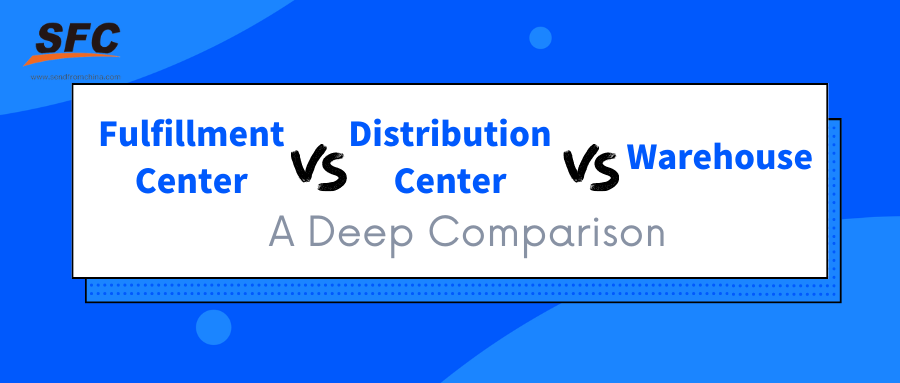Table of Contents
A Deep Comparison: Fulfillment Center vs Distribution Center vs Warehouse
Time: Aug 03,2023 Author: SFC Source: www.sendfromchina.com
When it comes to logistics and supply chain management, businesses often encounter three crucial components: fulfillment centers, distribution centers, and warehouses. While they all play pivotal roles in ensuring smooth operations and timely delivery of products, they differ in functions and purposes.
In this article, we will explore the features and distinctions of fulfillment centers, distribution centers, and warehouses, assisting businesses in making informed decisions about which option best aligns with their specific needs.

1.Features of Fulfillment Center, Distribution Center, and Warehouse
Before making a deep comparison, let's first understand the key features of each facility.Fulfillment Center Features
Fulfillment centers primarily focus on order fulfillment and customer delivery. They serve as central hubs for storing inventory and processing incoming orders. Fulfillment centers are equipped with advanced technologies that enable efficient picking & packing, and shipping processes. Their goal is to ensure that customers receive their orders accurately and promptly, fostering high levels of customer satisfaction and retention.Distribution Center Features
Distribution centers are responsible for receiving, storing, and redistributing goods within a broader network. Unlike fulfillment centers, distribution centers are not directly involved in processing individual customer orders.Instead, they manage inventory for multiple retail locations, wholesale partners, or other distribution centers. These facilities aim to optimize supply chain efficiency and reduce transportation costs by strategically locating inventory closer to the end consumer.
Warehouse Features
Warehouses, on the other hand, provide general storage for products without the added emphasis on order fulfillment or redistribution. They act as secure holding spaces for bulk inventory, offering businesses flexibility and scalability in managing their stock. Warehouses are particularly useful for businesses with diverse product lines or seasonal fluctuations in demand.2.Fulfillment Center vs Warehouse
Now, we have a basic understanding of each facility's features, let's explore the key differences between fulfillment centers and warehouses.Definition and Purpose
A fulfillment center primarily focuses on the efficient processing of customer orders, ensuring fast and accurate delivery. Its purpose is to enhance the customer experience by reducing delivery times and meeting customer expectations for order fulfillment.On the other hand, a warehouse serves as a storage space for inventory, with a broader focus on providing secure and organized storage for products. Warehouses do not directly handle order processing or shipping but play a crucial role in inventory management.
Operations and Services
Fulfillment centers are highly automated, utilizing state-of-the-art technologies to optimize order processing and fulfillment. They employ efficient order picking & packing systems, often integrating robotics and AI to increase speed and accuracy.Warehouses, while still benefitting from some automation, are not as heavily automated as fulfillment centers. They primarily focus on maximizing storage space and may not have the same level of order processing efficiency as fulfillment centers.
Advantages and Limitations
Fulfillment centers excel in delivering a superior customer experience. With streamlined order processing and faster shipping times, businesses can build customer loyalty and gain a competitive edge in the market. However, fulfillment centers may have limited storage space, making them less suitable for businesses with significant inventory needs.Warehouses, on the other hand, provide ample storage capacity, making them ideal for businesses with larger and diverse inventories. They offer the flexibility to hold inventory for extended periods, catering to seasonal demand fluctuations. However, warehouses may not offer the same level of speed and efficiency in order processing as dedicated fulfillment centers.
3.Fulfillment Center vs Distribution Center
While fulfillment centers and distribution centers share some similarities, they have distinct roles and functions within the supply chain.Key Differences in Functionality
The primary function of a fulfillment center is to process individual customer orders and prepare them for delivery. Fulfillment centers operate with the end consumer in mind, ensuring timely delivery and order accuracy.On the other hand, distribution centers focus on managing inventory for various retail locations, wholesale partners, or other distribution centers. They optimize the flow of goods through the supply chain, redistributing inventory as needed to meet regional or local demand.
Inventory Management and Order Fulfillment
In a fulfillment center, inventory management revolves around real-time order processing. The goal is to maintain sufficient inventory levels to fulfill customer orders promptly without overstocking.In a distribution center, inventory management is more complex, involving strategic planning to meet the demands of multiple locations or partners. They aim to optimize inventory allocation and minimize transportation costs.
Optimizing Supply Chain Efficiency
Fulfillment centers play a critical role in the last-mile delivery of products, ensuring that orders reach customers swiftly and accurately. By focusing on order fulfillment, they contribute to the overall efficiency of the supply chain.Distribution centers focus on reducing transportation costs and improving overall supply chain efficiency. They strategically position inventory closer to end consumers, reducing shipping distances and delivery times.
4.Distribution Center vs Warehouse
Now, let's explore the differences between distribution centers and warehouses, two facilities that primarily focus on inventory storage and management.Understanding Distribution Center Roles
Distribution centers function as intermediaries between manufacturers and retailers or end consumers. They act as central hubs for storing and redistributing inventory to meet regional or local demand.On the other hand, warehouses are versatile storage spaces that hold inventory for various purposes. While they can serve as distribution centers, warehouses may also store inventory for manufacturing, wholesale, or other business needs.
Warehouse Functions and Scope
Warehouses offer a broad scope of services, from inventory storage and management to order consolidation and even value-added services like kitting or repackaging.Distribution centers focus primarily on inventory redistribution, ensuring that the right products are delivered to the right locations at the right time.
Overlapping Characteristics
Despite their differences, distribution centers and warehouses share some common characteristics. Both play essential roles in supply chain management by providing safe and secure storage for inventory. Additionally, both facilities are critical in maintaining efficient inventory flow and meeting customer demand.5.How to Choose Between Fulfillment Center, Distribution Center, and Warehouse
Choosing the right facility for your business depends on various factors, and there is no one-size-fits-all solution. Here are some essential considerations to make an informed decision:Assessing Business Needs and Goals
Start by understanding your business's specific requirements. If you prioritize speedy and accurate order fulfillment, a fulfillment center may be the best fit. On the other hand, if you focus on optimizing inventory distribution and reducing transportation costs, a distribution center might be the better choice. If you need ample storage for diverse inventories, a warehouse could be the ideal solution.Evaluating Location and Proximity
Consider the geographic location of your customers and distribution network. If your business serves a wide range of regions, strategically located distribution centers can reduce shipping times and costs. For businesses with concentrated customer bases, fulfillment centers located near your target market can ensure swift deliveries.Cost Considerations and Scalability
Budget plays a crucial role in your decision-making process. Fulfillment centers may have higher operating costs due to their advanced automation and order processing capabilities. Distribution centers might be more cost-effective for businesses with large-scale inventory redistribution needs. Warehouses offer flexible and scalable storage options, making them suitable for businesses with fluctuating inventory demands.6.Conclusion
In conclusion, fulfillment centers, distribution centers, and warehouses are essential components of the modern supply chain. Each facility serves specific functions and purposes, and businesses must carefully assess their individual needs and goals to make the right choice. While fulfillment centers excel in fast and accurate order fulfillment, distribution centers optimize inventory distribution, and warehouses provide versatile storage solutions.The emergence of SFCs further expands the possibilities, offering a comprehensive integration of fulfillment and distribution services. By understanding the features and distinctions of these facilities, businesses can make informed decisions to optimize their logistics and meet customer demands efficiently.
FAQs
1.Are fulfillment centers only suitable for online retail businesses?
While fulfillment centers are commonly associated with online retail businesses, they can benefit various industries that require efficient order fulfillment, including subscription box services, direct-to-consumer brands, and ecommerce businesses.2.Can a business use both a fulfillment center and a warehouse?
Yes, some businesses may utilize both a fulfillment center and a warehouse in their supply chain. They may store bulk inventory in a warehouse and transfer a portion of that inventory to a fulfillment center for order fulfillment as needed.3.What factors should I consider when choosing a distribution center location?
When selecting a distribution center location, consider factors such as proximity to major transportation routes, access to key markets, labor availability, and local regulations. Choosing a strategically located distribution center can significantly impact supply chain efficiency.4.Is the integration of fulfillment and distribution centers suitable for all businesses?
While the integration of fulfillment and distribution centers can offer significant benefits, it may not be the optimal solution for all businesses. Smaller enterprises or businesses with specific niche markets may find more value in specialized facilities tailored to their unique needs.5.How can businesses ensure seamless integration between different logistics facilities?
To achieve seamless integration, businesses should invest in robust supply chain management software and systems that provide real-time visibility into inventory levels, order status, and shipment tracking. Effective communication and collaboration between teams in different facilities are also crucial to streamline operations. Post Views:12693
Post Views:12693
Copyright statement: The copyright of this article belongs to the original author. Please indicate the source for reprinting.
Previous Post
Ship From China to Canada: All You Need To Know
Next Post
TAGS
Hot Research
Get a Custom China Fulfillment Solution with FREE Storage for 30 Days
 Want to know about our services, fees or receive a custom quote?
Want to know about our services, fees or receive a custom quote?
 Please fill out the form on the right and we will get back to you within a business day.
Please fill out the form on the right and we will get back to you within a business day.
 The more information you provide, the better our initial response
will be.
The more information you provide, the better our initial response
will be.






 TAGS:
TAGS: